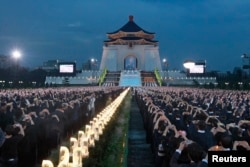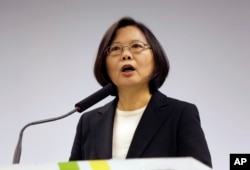Taiwan lawmakers are debating whether to remove the island’s pre-eminent landmark to former strongman Chiang Kai-shek as his party fades from power and citizens resent his violent suppression of dissent in the mid-20th century.
Chiang’s 6.3-meter bronze statue sits now in a tall Chinese-style pavilion that anchors a Taipei plaza that has become one of the capital city’s chief tourist landmarks. The monument opened in 1980 to remember Chiang as Taiwan’s leader from the mid-1940s until his death in 1975. His Nationalist Party ruled all of China until Chiang relocated in Taiwan after losing the Chinese civil war to Mao Zedong’s Communists.
Re-examining Chiang Kai-shek
Since Taiwan democratized in the late 1980s, Taiwanese have put the authoritarian ruler’s martial law and legacy of killing of suspected dissidents under a harsh spotlight. The Nationalists lost control of parliament in February and will step down from the presidency May 20. Their departure is making it easy for the soon-to-be new ruling Democratic Progressive Party (DPP) and its supporters in parliament to re-examine the major Chiang monument.
“I believe a lot of people think it should be redone, as this memorial honors Chiang Kai-shek and in the future to commemorate Chiang Kai-shek I think is strange, as there are a lot of things for which he needs to take responsibility,” says Hsu Yung-ming, a minor party legislator who held a hearing last week on the memorial’s fate.
Martial law under Chiang
Under Chiang’s rule, thousands were killed and tens of thousands jailed during campaigns to eliminate opponents. Chiang also imposed an unusually long period of martial law that lasted from 1949 until 1987, 12 years after his death.
Legislators have entertained suggestions of turning the Chiang Kai-shek Memorial Hall into archives for all Taiwanese presidents, making it a place to honor protest movements and recasting it to highlight the pains of Taiwan’s authoritarian history. Some also advocate demolition of all or parts of the memorial site, but others fear that move would divide society.
Memorials and statues
Effigies of the former strongman still blanket Taiwan. Bronze or stone statues – which normally show Chiang balding, smiling and often wearing military garb – greet children at parks and public schools. About 150 statues form a theme park in the hills southwest of Taipei. The Taipei Times newspaper estimated 43,000 Chiang statues were mounted around Taiwan as of 2000.
Backed by popular distaste for Chiang’s rule, the DPP government removed his name from the plaza where the memorial sits while it was in power between 2000 and 2008. In 2014, high school activists asked to have statues removed from their campuses and vandals periodically deface statues in public places.
Chiang has defenders
Some Taiwanese still consider Chiang’s role in history too important to justify removing his statue from the memorial. Some also like what he did to resist Communist China, effectively keeping Taiwan out of its reach. Beijing has claimed sovereignty over the island since the civil war ended in 1949, but each side has been separately ruled since then.
Slightly more than 7 million people, including foreign tourists visited the memorial hall and its surrounding plaza, gardens and exhibition halls in 2015.
New ruling party and president in charge
The Democratic Progressive Party won the presidency and parliamentary majority in January largely because of popular discontent with the Nationalists under President Ma Ying-jeou. Voters, according to opinion polls, said Ma had grown too close to China and out of touch with common people’s economic issues.
Joanna Lei, chief executive officer of the Chunghua 21st Century Think Tank in Taiwan, said any effort to destroy the memorial, from the statue to the plaza’s outer walls, would be political.
“It is a highly political and ideologically driven move by the new [Democratic Progressive Party] to eradicate all records, especially the records of Chiang Kai-shek, who brought lots of people from mainland China to Taiwan,” Lei says. “So if they are trying to gradually phase out the connection with mainland China, then taking the roots would be a very important political move.”
Legislators are now weighing a draft bill that notes intent to re-evaluate the monument’s symbolism, but it’s unlikely to recommend specific action, said Lee Chun-yi, head of parliament’s Internal Administration Committee. Lawmakers can later consider specific proposals for changes to the monument, he said.










